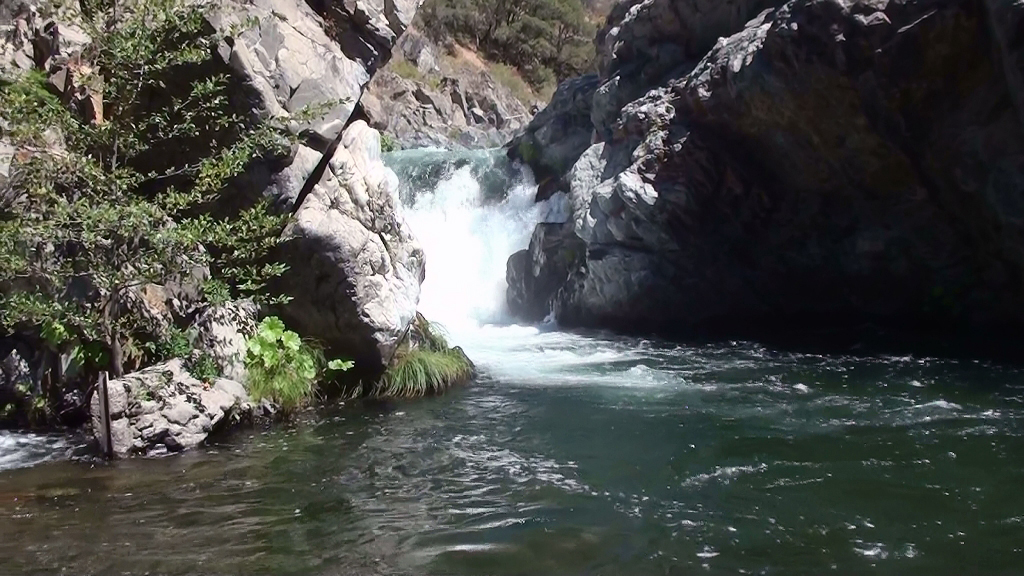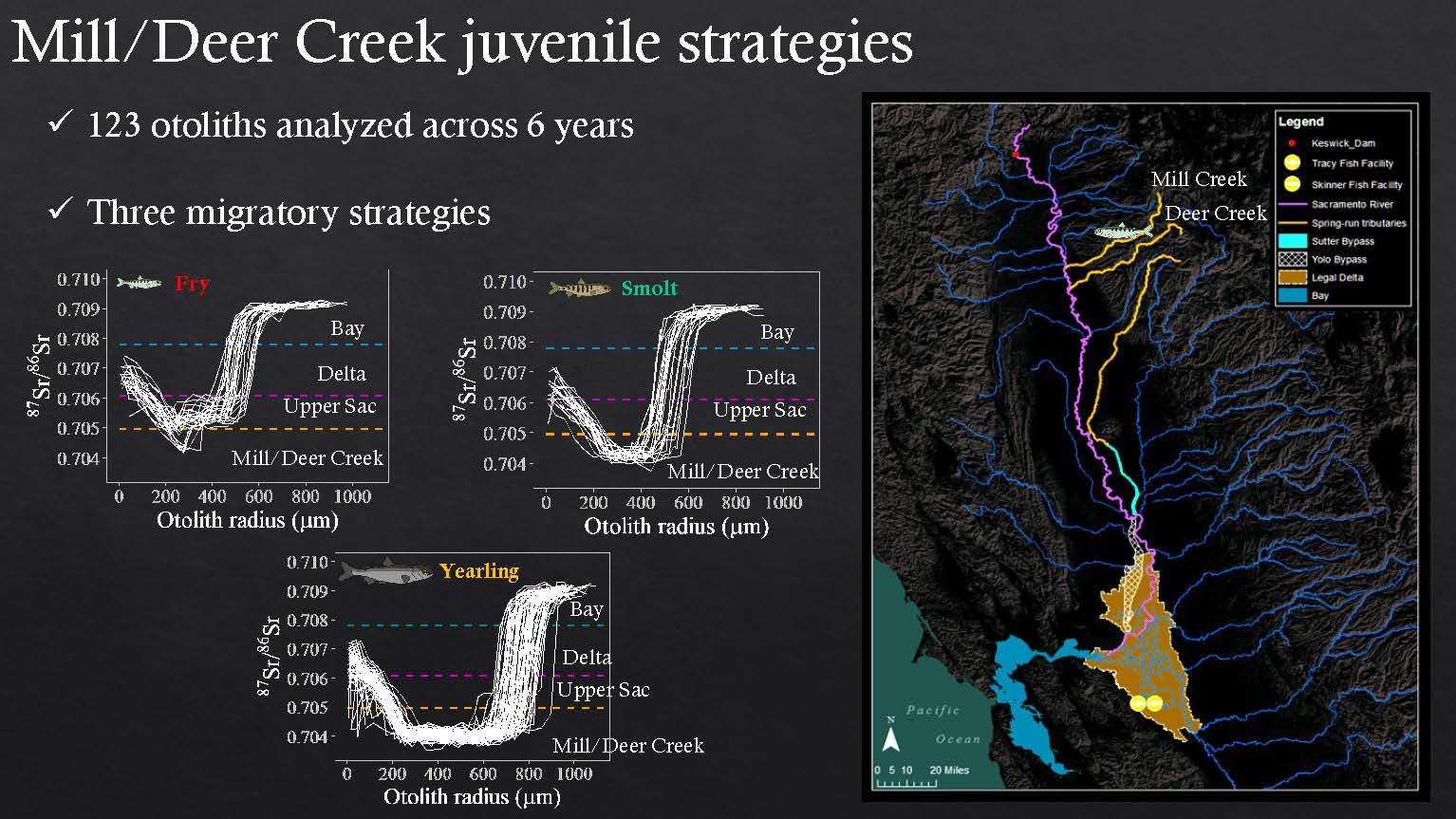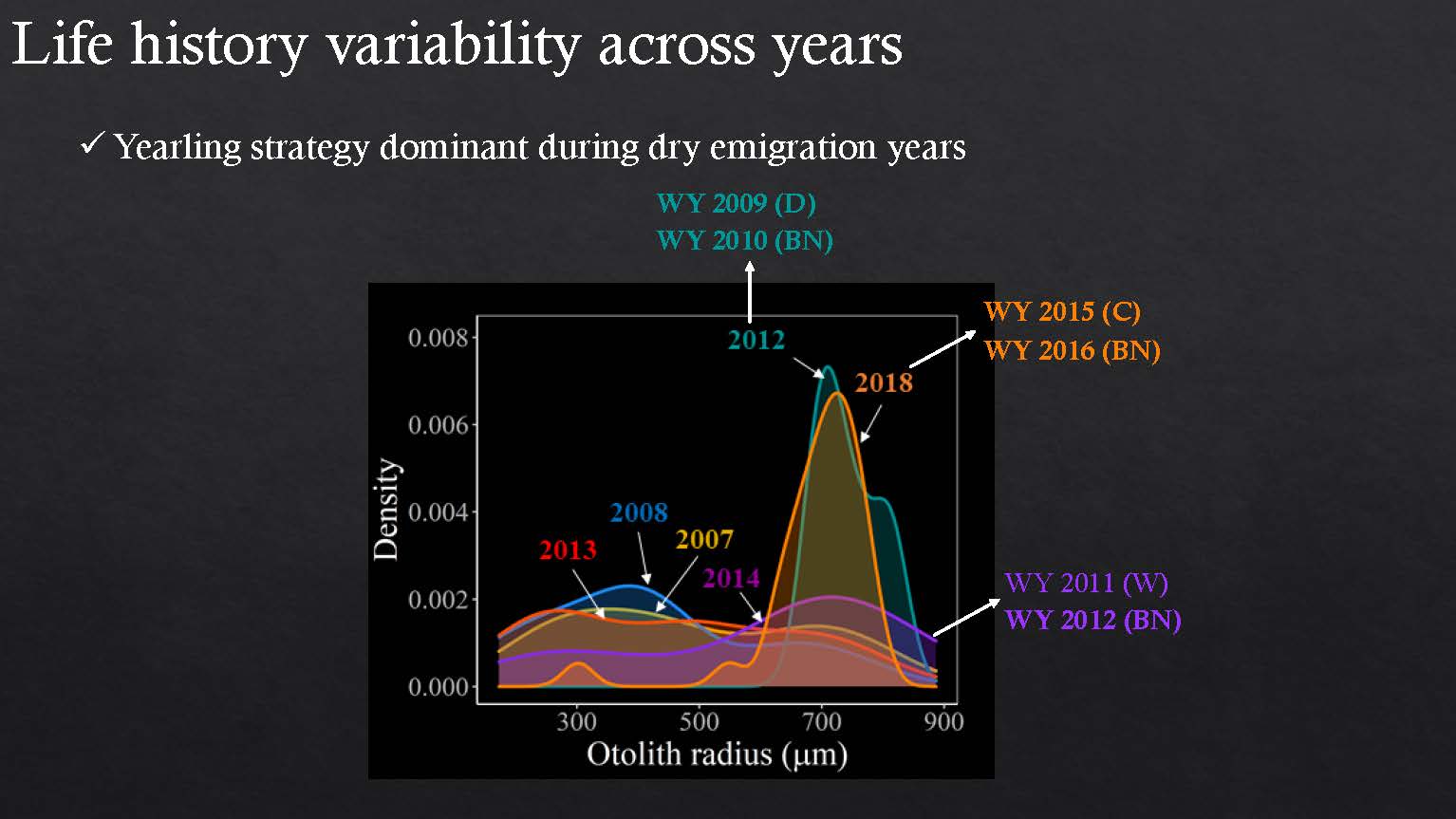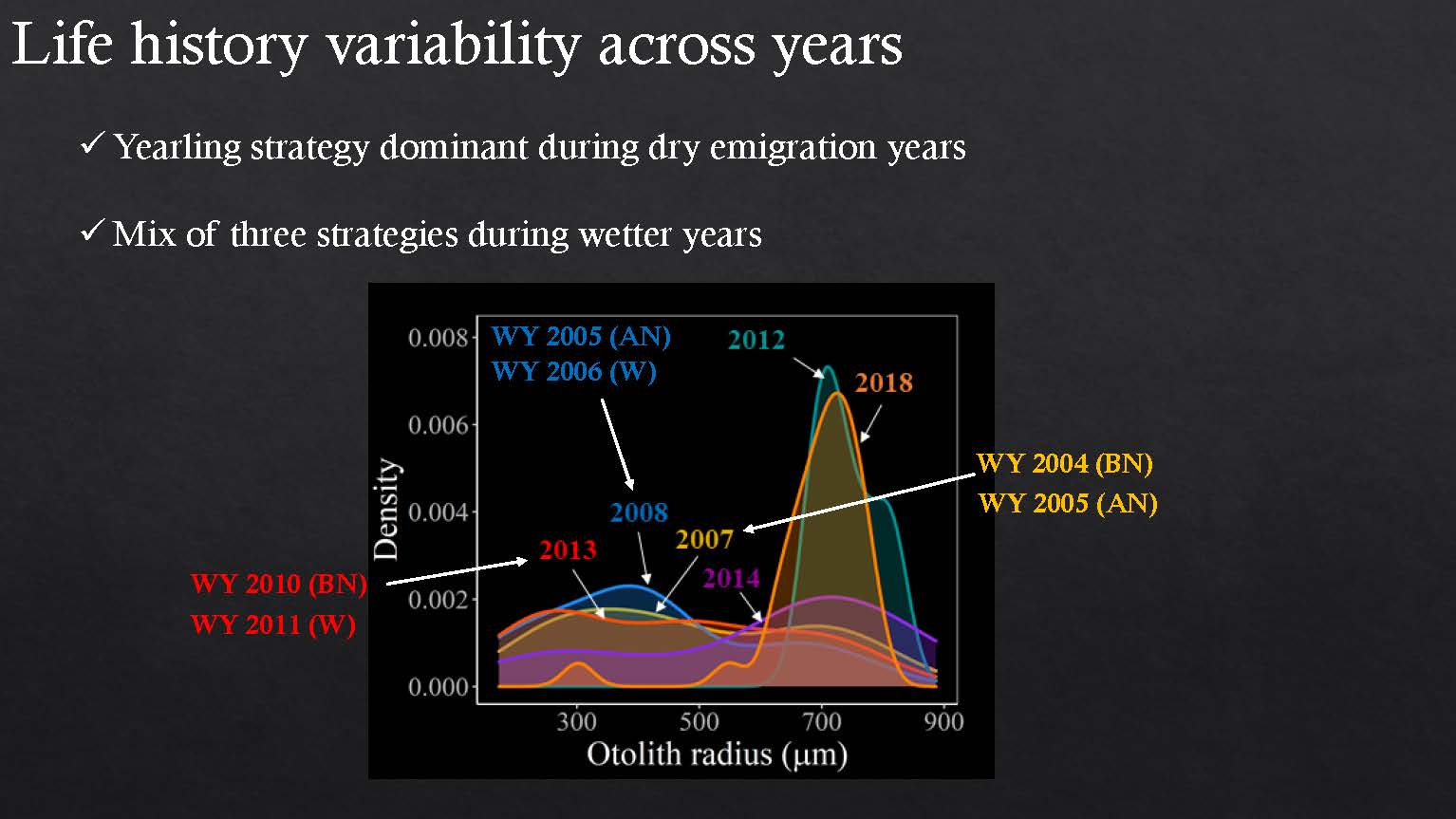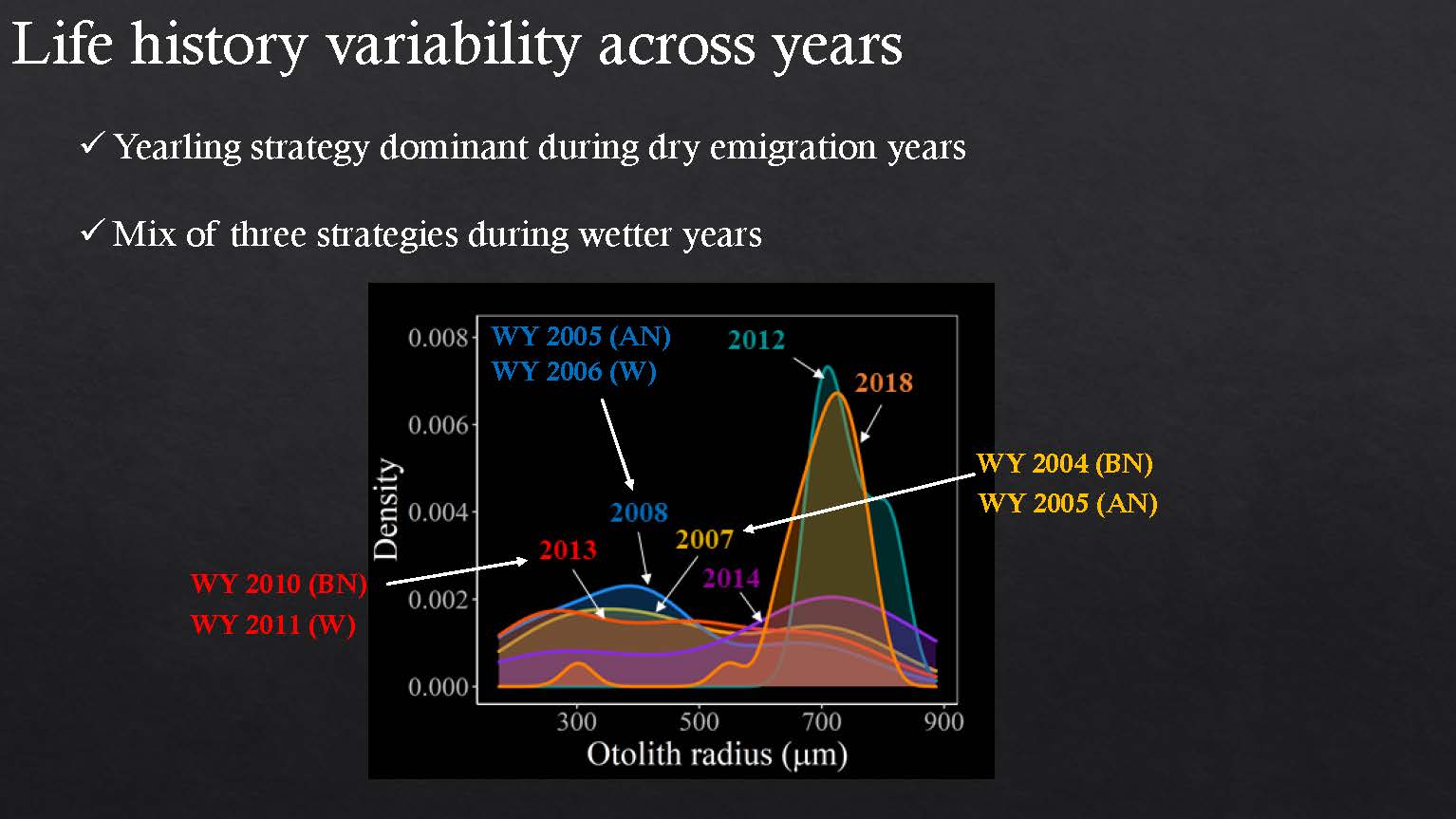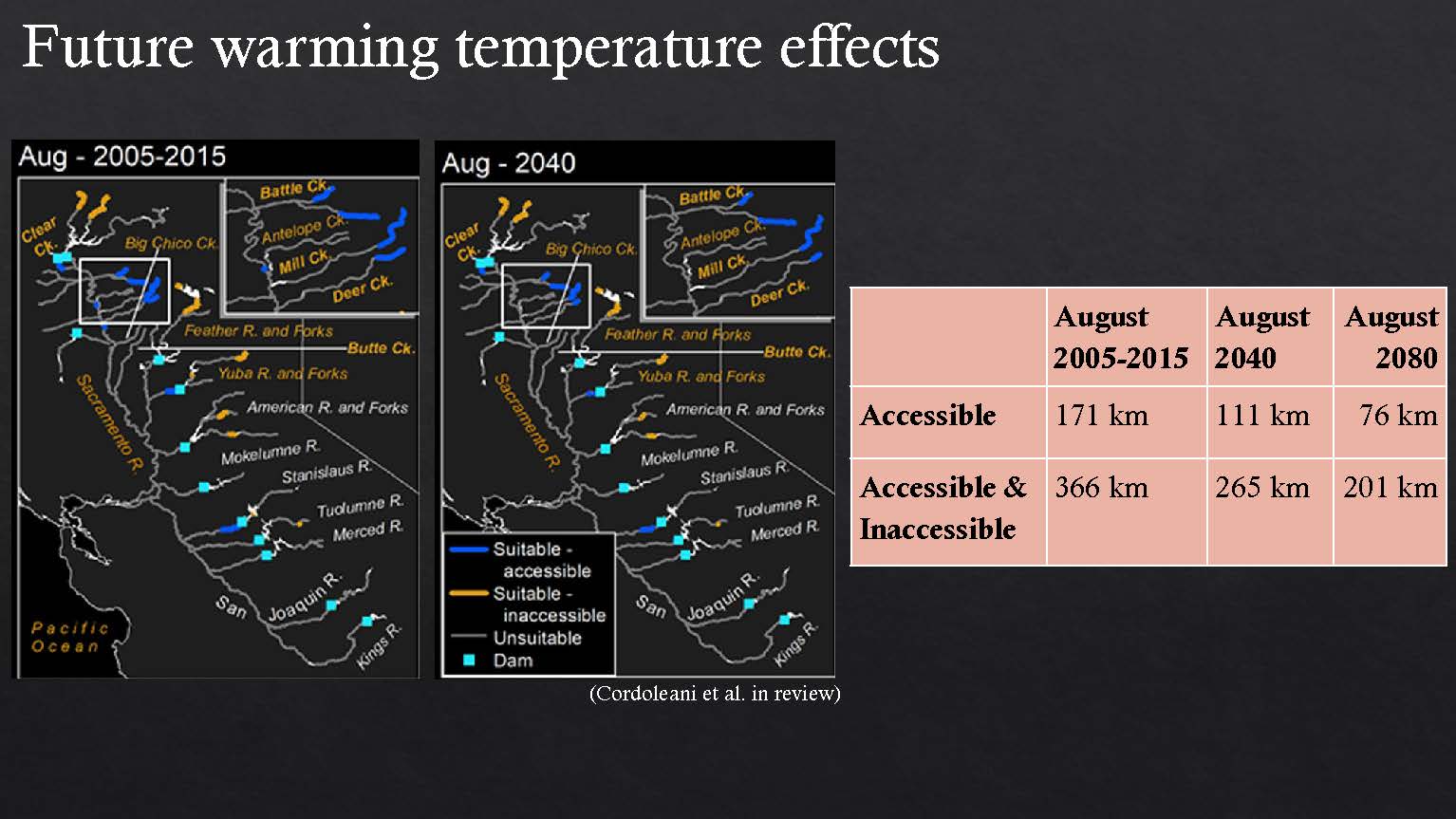Dr. Flora Cordoleani is a project scientist with UC Santa Cruz and NOAA fisheries, where she conducts research to understand better the dynamics of threatened populations of spring-run chinook salmon in the Central Valley’s highly modified environment, with the objective of providing management recommendations for the recovery of the species.
 At the 2022 Bay-Delta Science Conference, Dr. Cordoleani discussed research done in collaboration with Dr. Corey Phillis, Dr. Anna Sturrock, Dr. Rachel Johnson, and George Whitman that studied fish ear bones, also called otoliths, to look at the life history strategies of the spring-run Chinook salmon population in the Central Valley.
At the 2022 Bay-Delta Science Conference, Dr. Cordoleani discussed research done in collaboration with Dr. Corey Phillis, Dr. Anna Sturrock, Dr. Rachel Johnson, and George Whitman that studied fish ear bones, also called otoliths, to look at the life history strategies of the spring-run Chinook salmon population in the Central Valley.
California’s highly variable climate is marked by cycles of floods and droughts, sometimes even in the same year. In addition to this natural volatility, Central Valley rivers have been heavily modified due to dam construction, mining, water diversion projects, and the construction of levees for flood control. This has led to the loss of 95% of the Central Valley’s floodplains, blocking access to most of the high elevation habitats that now lie above the dams.
 This loss and degradation of the river habitat have taken a huge toll on the Central Valley chinook population, especially the spring-run population, one of four runs of Chinook salmon in the Central Valley. The spring-run salmon run was once one of the most abundant runs and could be found in any major stream of the Sacramento River and the San Joaquin River Basin. Spring-run salmon are now listed as threatened under the Endangered Species Act. Currently, there are only three self-sustaining populations of spring-run Chinook salmon in the Sacramento River Basin: Mill, Deer, and Butte Creeks.
This loss and degradation of the river habitat have taken a huge toll on the Central Valley chinook population, especially the spring-run population, one of four runs of Chinook salmon in the Central Valley. The spring-run salmon run was once one of the most abundant runs and could be found in any major stream of the Sacramento River and the San Joaquin River Basin. Spring-run salmon are now listed as threatened under the Endangered Species Act. Currently, there are only three self-sustaining populations of spring-run Chinook salmon in the Sacramento River Basin: Mill, Deer, and Butte Creeks.
Spring-run chinook salmon life history strategies
As a review, the life cycle of salmon begins with emergence from the egg to becoming a fry; then there is rearing among different habitats, such as the upper river, lower river, floodplain, and Delta habitat; undergoing smoltification, and then out-migration to the ocean. After spending 2 – 4 years in the ocean, the adult salmon return to their natal tributary to spawn and begin the cycle anew.
Spring-run chinook salmon are characterized by their ability to adapt to changes in the environment or various habitats (called plasticity) that make it possible for the population to buffer disturbances. This plasticity is expressed through multiple life history strategies throughout multiple stages of their life. In particular, they exhibit different juvenile rearing and migratory strategies during the freshwater phases.
 The graphic on the lower right of the slide shows the size of the fish leaving the natal tributary from November to June.
The graphic on the lower right of the slide shows the size of the fish leaving the natal tributary from November to June.
There are three main migratory strategies observed in this population: The young fish rear for various amounts of time in the natal reach of the stream after emergence before migrating to the ocean within the first year after emergence. Some will stay a short time and leave as fry to downstream habitats, shown in red; others will rear in the natal stream for two months before leaving as parr or smolt during the first spring, shown in green. Still others will stay in the natal reaches an entire year before migrating as yearlings to the ocean the following fall, winter, or spring, shown in yellow.
The data for the chart came from rotary screw traps which collect the juvenile salmon when they outmigrate from the tributary. The first question for the researchers was, which one of those life history strategies are most represented in adults returning to spawn? The second question was, how does the successful rearing strategy vary among different hydrological years, such as wetter or drier years?
Looking for answers in the otoliths
 To answer those questions, the researchers used spring-run adult otoliths (or ear bones) collected by the Department of Fish and Wildlife during the carcass survey conducted each year to estimate spawner abundance.
To answer those questions, the researchers used spring-run adult otoliths (or ear bones) collected by the Department of Fish and Wildlife during the carcass survey conducted each year to estimate spawner abundance.
“The otoliths allow us to estimate juvenile growth rates because, like trees, otoliths make rings or increments through time, and so we can estimate the width between each of the increments, which give us an estimate for juvenile growth,” said Dr. Cordoleani.
Additionally, the otoliths contain a record of the habitats and the migratory history of the juvenile salmon. Because the strontium isotope ratio of freshwater habitats varies as a function of geology and weather pattern, there are significant differences in isotope signature among most of the streams in the Central Valley where juvenile salmon are found.
“Otoliths are incredible markers because they record the strontium signature of the water in which individual fish has spent time,” said Dr. Cordoleani. “So variations in strontium concentration found in the otoliths can be used to reconstruct juvenile salmon rearing and migration behavior.”
Mill/Deer Creek juvenile strategies
She first presented the results for the Mill and Deer Creek population. Since the populations are very close geographically and genetically, they combined the otoliths on those two streams, analyzing 123 otoliths across six different years, from 2007-2018.
On the graphs on the slides, the strontium transform ratios (which vary across watersheds) are on the y axis; the x-axis is the otolith radius, which is a proxy for fish size. In the beginning, all the profiles have a decreasing strontium value phase, which corresponds to the incubation time; what the researchers are most interested in is the phase from the minimum value until they migrate to the ocean, which corresponds to where the fish spent its rearing time after emergence from the gravel.
The three migratory strategies found in the rotary screw trap data were also found to be prevalent in the Mill and Deer Creek adult population:
- The graph on the upper left shows the early migrant strategy, which are fry-sized fish that leave the natal tributary shortly after emergence to rear in the Sacramento River for a few months before leaving as smolt size for the ocean.
- The graph on the upper right shows the second strategy observed, which are fish that stayed in the natal stream for a few months after emergence, migrating to the ocean as smolt-sized fish.
- The lower graph shows the fish which stayed over summer, finally leaving the natal tributary the following fall as yearling size.
To look at how the strategy varies across years, the density plot below shows the fish size when they exited the natal tributary for each returning year. For years 2012, 2018, and to some extent, 2014, Dr. Cordoleani noted that most fish left at a large size corresponding to yearling size at outmigration.
“If we consider that those fish are three or four years old, which is the most common age for spring-run adults returning to spawn, we can reconstruct the juvenile outmigration year,” she said. “So those return years correspond to a migration year that was classified either as below normal, dry, or critically dry by the California Department of Water Resource. So what that means is that the yearling strategy seems to be dominant during dry migration conditions.”
“On the other hand, during return years 2007, 2008, and 2013, we see a more diverse distribution of fish size at natal exit, and those return years correspond to a migration year that was classified as above normal or below normal or wet years,” she continued. “So that means that during wetter conditions, we see a selection of the three strategies in the adult population.”
Butte Creek salmon population
The map below shows the Butte Creek watershed in yellow, and the Sutter Bypass, which is part of the lower Butte Creek watershed, shown in green. Researchers analyzed 558 otoliths across 14 years from 2003 to 2018. The analysis of the strontium isotope profiles found that one main migratory strategy was observed across all years, which is represented on the chart by the white line.
“This strategy was that fish left the upper Butte Creek watershed pretty quickly after emergence and reared for a few months in the lower Butte Creek watershed, such as the Sutter Bypass, until they reach smolt size and left the tributary to the ocean quickly after,” said Dr. Cordoleani.
There were also a few early migrants that were fry-sized that left the Butte Creek watershed to rear in downstream habitats in the Sacramento River and the Delta before leaving to the ocean, as well as a few larger-sized migrants in the 2017 spawner cohorts, but those were very few fish, she said.
Comparing Mill/Deer Creek and Butte Creek juvenile strategies
The chart on the slide compares the sizes of the Butte Creek population at the time of leaving the natal tributary, shown in orange, with that of the Mill and Deer Creek population, in green, blue, and purple. The chart shows that most of the juvenile salmon left the lower Butte Creek watershed at sizes similar to Mill and Deer Creek smolt strategies, with a few early migrants.
The chart on the slide below shows the time at which the fish leave the natal tributary on the x-axis in increment number, which is a proxy for number of days since emergence.
“The majority of Butte Creek juvenile left the Sutter Bypass at times that are similar to times when Mill and Deer Creek smolt juvenile left the natal tributary,” said Dr. Cordoleani. “We do not see any fish leaving at times that are consistent with a yearling life history strategy. So that means that those 2017 fish seem to have grown larger, faster, in a shorter amount of time, than Mill and Deer Creek yearling fish.”
This led the researchers to look at the differences in juvenile growth among these populations. This chart shows the growth curve figures for Butte Creek on the left and Mill and Deer Creek on the right. The y axis shows the increment width calculated for each two consecutive increments, and the x-axis shows the increment number, which is a proxy for days since emergence.
Dr. Cordoleani noted several things: “First, the maximum increment number is higher, so there are larger increment widths for Butte Creek population than for Mill and Deer Creek population. The peak growth happened earlier in Butte Creek population versus Mill and Deer Creek population; 50 versus around 100 days on average. Also, the residence time in freshwater is shorter for Butte Creek fish; the increment number ends around 50 versus Mill and Deer Creek population, which stayed more than 300 days in freshwater. This means that natural faster growth was observed in the Butte Creek population.”
“We also can see that larger interannual growth in the Mill and Deer Creek population was observed in comparison to Butte Creek where the growth curves are closer to each other and more similar,” she said. “All this is consistent with what was observed in the strontium isotope profile. And this led us to hypothesize that early life growth is likely influencing the juvenile rearing and migratory strategy selection in those populations.”
Looking to the future with climate change
Finally, to explore how juvenile growth and life history strategy selection may be impacted by weather conditions and future warming temperatures due to climate change, the researchers modeled current and future thermal conditions along every stream in the Central Valley where spring-run were either historically or currently found.
The chart and the map on the slide show the amount of thermally-suitable habitat for August during current years from 2005-2017, for the year 2040, and the year 2080. A reach was considered thermally suitable if the temperature remained below 15 degrees Celsius.
The dark blue color shows suitable habitats accessible to the spring-run population; the yellow color shows suitable habitats that are inaccessible due to dams or natural barriers. The only streams where accessible rearing habitat is available in August are Mill, Deer, Battle Creek, and some reaches in the Yuba and Stanislaus Rivers.
“The amount of suitable rearing habitat is predicted to shrink for both accessible and inaccessible habitats due to a warming climate,” said Dr. Cordoleani. “Juvenile salmon may only access about 76 kilometers of suitable summer habitats by August 2080, which is around half of what is currently accessible based on these predictions. However, suitable riverine habitat for rearing could approximately triple if salmon were provided access above dams in the Sacramento River or multiple rivers in San Joaquin basin.”
Conclusions and implications
Dr. Cordoleani then gave the conclusions and implications of the study. Juvenile life history diversity seems to play an important role in the Mill and Deer Creek population as a response to environmental variability; in particular, the yearling strategy appears to be critical for facing drought conditions. So, maintaining or restoring access to thermally suitable habitat, especially for the yearling life history strategy, might be important to support the spring run population that has this life history strategy in their portfolio.
On the other hand, even though the Butte Creek population does not have temperature conditions that allow the yearling phenotype, they were successful because of high growth conditions in the Butte Creek watershed.
“The likely key for the success of this population is the fact that this population has a unique access to one of the last floodplain habitats in Central Valley, which is the Sutter Bypass,” said Dr. Cordoleani. “So maintaining access to this Sutter Bypass and off-channel habitats that allow providing productive condition and high growth condition for this juvenile salmon may be key to support this population in future climates.”
Threatened salmon rely on a rare life history strategy in a warming landscape
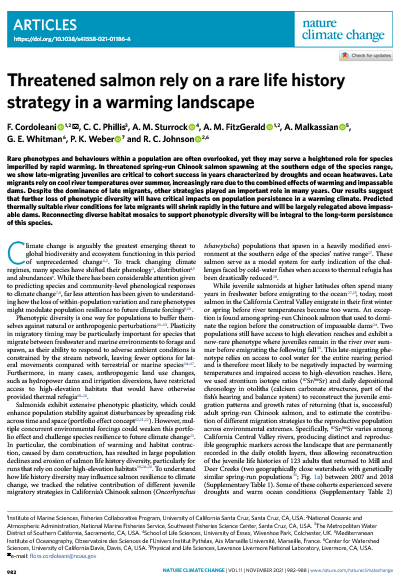 Authors: F. Cordoleani, C. C. Phillis, A. M. Sturrock, A. M. FitzGerald, A. Malkassian, G. E. Whitman, P. K. Weber, and R. C. Johnson
Authors: F. Cordoleani, C. C. Phillis, A. M. Sturrock, A. M. FitzGerald, A. Malkassian, G. E. Whitman, P. K. Weber, and R. C. Johnson
Abstract: Rare phenotypes and behaviours within a population are often overlooked, yet they may serve a heightened role for species imperilled by rapid warming. In threatened spring-run Chinook salmon spawning at the southern edge of the species range, we show late-migrating juveniles are critical to cohort success in years characterized by droughts and ocean heatwaves. Late migrants rely on cool river temperatures over summer, increasingly rare due to the combined effects of warming and impassable dams. Despite the dominance of late migrants, other strategies played an important role in many years. Our results suggest that further loss of phenotypic diversity will have critical impacts on population persistence in a warming climate. Predicted thermally suitable river conditions for late migrants will shrink rapidly in the future and will be largely relegated above impassable dams. Reconnecting diverse habitat mosaics to support phenotypic diversity will be integral to the long-term persistence of this species.
Click here to read/download this research article.
Click here for the press release from NOAA.


